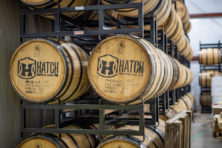Wine Trails: A Tale of Two Wines
- Share
- Tweet
- Pin
- Share

I will begin by apologizing to Charles Dickens.
It was the best of wines, and it should have been the worst of wines. It was a wine delicately and meticulously aged; it was a wine of recent crushing. It was a wine of respect, and it was a wine to be consumed in foolishness and fun.
This is a tale of a Malbec and a Frontenac.
The best way to describe my relationship with Malbec is to paraphrase the late humorist Will Rogers: “I’ve never met a Malbec I didn’t like.” Therein lies the problem. It is a wine that can be counted on to be good, and I have sipped enough of it to seldom be surprised because of its consistent quality.
Frontenac is a hybrid grape that was developed for northern climates such as Wisconsin and released in 1996. Because of its youth, it has yet to gain a reputation as a source of serious wine. Winemakers in Door County are trying to change that by attempting to find a way to balance the grapes’ high sugar and acidity with its low tannins to produce a wine that’s complex enough to gain the respect of winemakers.
Russell Turco – owner and winemaker at Stone’s Throw Winery in Baileys Harbor – has been making great wines from California grapes for more than 25 years and recently added a Malbec to his portfolio.
During a recent sampling, my wife asked for a taste of the 2019 vintage Malbec and was so impressed that she took a bottle home. I opened it a few nights later, pairing it with what I believe were well-seasoned pork chops, but the food really didn’t matter. There was just something about the Malbec that made everything else irrelevant. It was as close to perfection as any wine I have ever tasted, and I have tasted a lot of wine.
I went to Vino! Vino! – the Tuscan wine and tapas bar next to Stone’s Throw’s Winery – to find Turco to ask him what made his Malbec so good.
It turns out that his winemaking skills played a larger role in the wine’s quality than the vineyard’s backstory. He explained that he had added a 15% full berry fermentation when creating the wine and aged it for a year in French oak Gamba barrels. The wine, he said, will continue to get better as it ages in the bottle. After talking to Turco, I went next door to Stone’s Throw’s tasting room and purchased a few more bottles to verify his prediction.
After my experience with Turco’s Malbec, I researched a Frontenac that was produced recently at Anchored Roots Winery in Egg Harbor, where I pour for owners Amy and Eric Gale.
I shy away from wines with any level of residual sugar, and I sprint away from red wines of any sweetness. But there was something about the Gales’ Frontenac that shocked me. I liked it. I mean I really liked it.
I asked Eric Gale to help me understand why my palate and his wine had developed such a fulfilling relationship. At first, he seemed surprised by my question, saying simply that he had put a great deal of care into making it.
I pressed further. He said it probably had to do with the balance of acidity and sweetness. Because cold-hardy hybrids such as Frontenac that are grown in Wisconsin don’t have a long enough growing season to lose their natural acidity, the wine they produce tends to be tart.
Winemakers compensate for this tartness by using sugar for balance – either by stopping the fermentation before all of the sugar is gone, or by adding sugar at the end. This is why Wisconsin wines tend to be sweet.
The goal, according to Gale, is to not overcompensate, leaving the wine tart, with only enough sugar to allow our taste buds to appreciate the natural balance between the natural acidity and sweetness of the juice. That explained why I noticed a very positive aftertaste when I drank his Frontenac: My taste buds were continuing their tasing of the residual wine long after clearing my mouth. It’s a sensation I have encountered with other exceptional wines.
I had my answers and realized that learning about wines directly from winemakers – especially those with the passion of Turco and Gale – leads to a greater appreciation of the fermented grape.
Jim Schnaedter describes himself as a wine appreciator, but not an expert. “I love drinking it, pouring it, talking about it and writing about it, but the more I do of each, the more I learn what I don’t know about it.” He sets out to discover more about Door County wines and their makers in this series.



